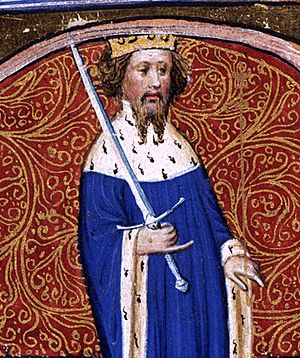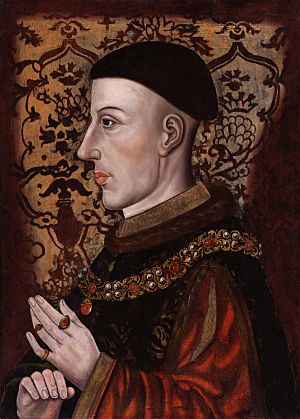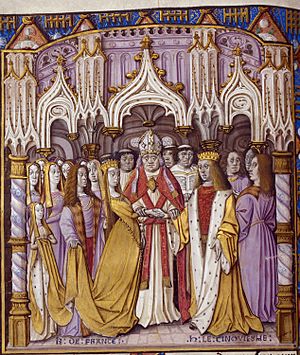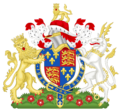Henry V of England facts for kids
Quick facts for kids Henry V |
|
|---|---|
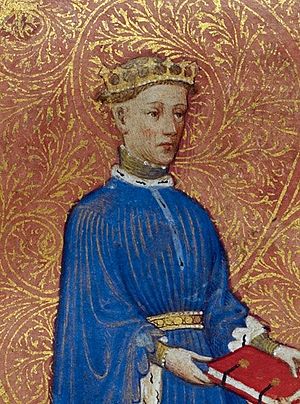
Miniature of Henry in the Regement of Princes by Thomas Hoccleve, c. 1411–1413
|
|
| King of England (more...) | |
| Reign | 21 March 1413 – 31 August 1422 |
| Coronation | 9 April 1413 |
| Predecessor | Henry IV |
| Successor | Henry VI |
| Born | 16 September 1386 Monmouth Castle, Wales, Kingdom of England |
| Died | 31 August 1422 (aged 35) Château de Vincennes, Kingdom of France |
| Burial | 7 November 1422 Westminster Abbey, London |
| Spouse | |
| Issue | Henry VI of England |
| House | Lancaster (Plantagenet) |
| Father | Henry IV of England |
| Mother | Mary de Bohun |
| Signature |  |
Henry V (born 16 September 1386 – died 31 August 1422), also known as Henry of Monmouth, was the King of England from 1413 until his death. Even though he ruled for a short time, Henry's amazing military wins in the Hundred Years' War against France made England a very strong military power in Europe. He is remembered in Shakespeare's plays and is celebrated as one of the greatest warrior-kings of medieval England.
While his father, Henry IV, was king, Henry gained military skills. He fought the Welsh during the revolt led by Owain Glyndŵr. He also fought against the powerful Percy family at the Battle of Shrewsbury. Henry took on a bigger role in England's government as his father's health got worse. However, disagreements between them caused some political problems. After his father died in 1413, Henry became king. He then strongly pushed England's claim to the French throne.
In 1415, Henry started a war with France. His first military campaign included his famous victory at the Battle of Agincourt in 1415. By 1420, his armies had captured Paris. They were close to taking over all of medieval France. He used the political fights within France to his advantage. He conquered large parts of Northern France. This led to Normandy being controlled by the English again. After many months of talks with Charles VI of France, the 1420 Treaty of Troyes recognized Henry V as the regent (ruler) and heir apparent (next in line) to the French throne. He then married Charles's daughter, Catherine of Valois. It seemed like England and France would become one kingdom under Henry. But he died two years later. His only child, the baby Henry VI, became king.
People have different opinions about Henry's reign. He was praised for his piety (strong religious belief), bravery, and military genius. Even French writers at the time admired him. However, some criticize his sometimes cruel nature and his lack of focus on problems at home. Still, his military actions during the Hundred Years' War created a strong sense of English nationalism. This helped set the stage for England, and later Britain, to become a powerful global nation.
Contents
Early Life and Challenges
Henry was born in a tower at Monmouth Castle in Wales. This is why he was sometimes called Henry of Monmouth. He was the son of Henry of Bolingbroke, who later became Henry IV of England. His mother was Mary de Bohun. His father's cousin was the king at the time, King Richard II. Henry's grandfather was John of Gaunt, a son of King Edward III.
Since he was not very close to the throne at birth, Henry's exact birth date was not officially recorded. For many years, people argued if he was born in 1386 or 1387. However, records show his younger brother Thomas was born in late 1387. Also, his parents were in Monmouth in 1386, but not in 1387. So, it is now accepted that he was born on 16 September 1386.
When Henry's father was sent away from England in 1398, King Richard II took care of the young Henry. The king treated him well. Young Henry even went with Richard to Ireland. While serving the king, he visited Trim Castle in County Meath. This was an old meeting place for the Parliament of Ireland.
In 1399, John of Gaunt died. In the same year, King Richard II was overthrown. Henry's father became king, starting the Lancastrian rule. Henry was called back from Ireland and became important as the heir apparent to the Kingdom of England. He was named Prince of Wales when his father was crowned. He also became Duke of Lancaster on 10 November 1399. He was the third person to hold that title that year. He also held the titles of Duke of Cornwall, Earl of Chester, and Duke of Aquitaine.
A record from 1399 shows that Henry spent time at The Queen's College, Oxford. He was looked after by his uncle Henry Beaufort, who was the university's chancellor. During this time, Henry learned to read and write. He also developed a love for literature and music. This made him the first English King to be educated in this way. He even gave money to composers because he loved music so much.
From 1400 to 1404, Henry worked as the High Sheriff of Cornwall. During this time, Henry also commanded some English forces. He led his own army into Wales against Owain Glyndŵr. He also joined his father to fight Henry "Hotspur" Percy at the Battle of Shrewsbury in 1403. At this battle, the 16-year-old prince was almost killed by an arrow. A normal soldier might have died from such a wound. But Henry received the best possible medical care.
For several days, John Bradmore, the royal doctor, treated the wound. He used honey to keep it clean. He also made a special tool to remove the arrow without causing more damage. Then he cleaned the wound with alcohol. The operation worked, but it left Henry with lasting scars. These scars showed his experience in battle. Bradmore wrote about this in Latin in his book Philomena. Henry's treatment was also described in an old English medical book from 1446.
Early Military Career and Government Role
The Welsh revolt led by Owain Glyndŵr kept Henry busy until 1408. After that, because the king was sick, Henry started to take a bigger part in politics. From January 1410, he had real control of the government. His uncles, Henry and Thomas Beaufort, helped him. They were legitimate sons of John of Gaunt.
Henry had different ideas from the king about foreign and home policies. The king removed his son from the council in November 1411. The disagreement between father and son was only about politics. It is likely that the Beauforts had talked about Henry IV giving up the throne. Their enemies certainly tried to spread bad rumors about Prince Henry.
The stories about Henry's wild youth, made famous by Shakespeare, might be partly due to political enemies. Henry's history of being involved in war and politics, even when he was young, shows these stories are not true. The most famous story, about his fight with the chief justice, has no proof from that time. It was first told by Sir Thomas Elyot in 1531.
The character of Falstaff came from Henry's early friendship with Sir John Oldcastle. Oldcastle supported the Lollards, a religious movement. Shakespeare's Falstaff was first named "Oldcastle." This was based on his main source, The Famous Victories of Henry V. Oldcastle's family objected, so the name was changed. That friendship, and the prince's political opposition to Thomas Arundel, Archbishop of Canterbury, might have given the Lollards hope. If so, their disappointment might explain why church writers like Thomas Walsingham said Henry suddenly changed when he became king.
Becoming King
After Henry IV died on 20 March 1413, Henry V became king. He was crowned on 9 April 1413 at Westminster Abbey. A big snowstorm happened during the ceremony. People weren't sure if it was a good or bad sign. Henry was described as "very tall (6 feet 3 inches), slim, with dark hair cut short above his ears, and clean-shaven." His face was reddish and thin, with a noticeable pointed nose. Depending on his mood, his eyes "flashed from gentle like a dove's to bright like a lion's."
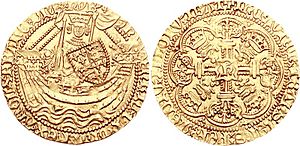
Henry dealt with all the problems at home and slowly built a bigger plan for his rule. From the start, he made it clear he would rule England as the leader of a united nation. He let past disagreements be forgotten. The late Richard II was honorably re-buried. The young Edmund Mortimer, 5th Earl of March, was brought back into favor. The families of those who had suffered under the last king slowly got their titles and lands back.
However, when Henry saw a serious danger at home, he acted strongly. For example, he dealt with the Lollard discontent in January 1414. This included executing his old friend Sir John Oldcastle by burning in 1417. This was done to stop the movement quickly and make his own position as ruler secure.
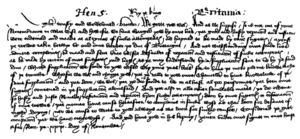
Henry's time as king was mostly free from serious problems at home. One exception was the Southampton Plot in July 1415. This plot supported Mortimer and involved Henry, Baron Scrope, and Richard, Earl of Cambridge. Mortimer himself stayed loyal to the King.
Starting in August 1417, Henry encouraged the use of the English language in government. His reign marks the start of Chancery Standard English. This was also when English became the official language for government records. He was the first king to use English in his personal letters since the Norman conquest 350 years earlier.
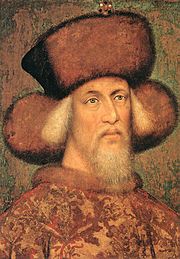
Henry could now focus on matters outside England. Some people later claimed that church leaders encouraged Henry to go to war with France. They said this was to distract from problems at home. But this story seems to have no basis. Old trade arguments and France's support for Owain Glyndŵr were used as reasons for war. Also, France was in a messy state, so peace was not guaranteed. King Charles VI of France often suffered from mental illness. His oldest living son was not a promising leader. However, it was the old claim to the French throne, first made by Edward III of England, that justified the war for the English.
After the Battle of Agincourt, King Sigismund of Hungary (who later became Holy Roman Emperor) visited Henry. He hoped to make peace between England and France. His goal was to convince Henry to ask for less from the French. Henry entertained him grandly. He even made Sigismund a member of the Order of the Garter. Sigismund, in return, made Henry a member of the Order of the Dragon. Henry had planned to go on a crusade for the order after uniting the English and French thrones. But he died before he could do this. Sigismund left England several months later. He had signed the Treaty of Canterbury, which recognized England's claims to France.
War in France
Henry might have seen asserting his claims as part of his royal duty. But a lasting solution to the national debate was key to his foreign policy success.
The 1415 Campaign
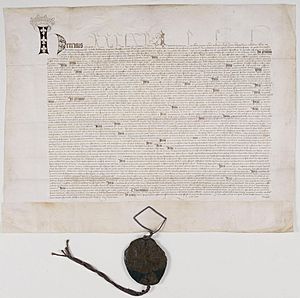
On 12 August 1415, Henry sailed to France. His forces attacked the fortress at Harfleur, capturing it on 22 September. After this, he decided to march his army across the French countryside toward Calais. This was against his council's advice. On 25 October, near the village of Agincourt, a French army blocked his path. Even though his soldiers were tired, outnumbered, and hungry, Henry led his men into battle. They decisively defeated the French, who lost many soldiers.
It is often said that the French soldiers got stuck in the muddy battlefield. Heavy rain the night before had soaked the ground. This slowed the French attack, making them easy targets for the English archers on the sides. Most were simply killed while stuck deep in the mud. Still, this victory is seen as Henry's greatest. It ranks with the Battle of Crécy (1346) and the Battle of Poitiers (1356) as the biggest English victories of the Hundred Years' War.
During the battle, Henry ordered that the French prisoners be killed. This included some important people who could have been held for ransom. Some historians believe Henry worried the prisoners might turn on their captors. This could happen if the English were busy fighting a third wave of enemy troops. This would risk a hard-won victory.
The successful end of Agincourt, from the English side, was just the first step. The goal was to get back the French lands that Henry believed belonged to the English crown. Agincourt also made it seem possible that Henry could become King of France.
Diplomacy and Further Campaigns
To control the sea, the English drove the Genoese allies of the French out of the English Channel. While Henry was busy with peace talks in 1416, a French and Genoese fleet surrounded the harbor at English-held Harfleur. A French land force also attacked the town. In March 1416, an English raiding force was attacked and barely escaped defeat at the Battle of Valmont.
To help the town, Henry sent his brother, John, Duke of Bedford. John gathered a fleet and sailed from Beachy Head on 14 August. The French-Genoese fleet was defeated the next day after a tough seven-hour battle. Harfleur was saved. Diplomacy successfully stopped Emperor Sigismund from supporting France. The Treaty of Canterbury, also signed in August 1416, confirmed a short alliance between England and the Holy Roman Empire.
The 1417–20 and 1421 Campaigns
With those two possible enemies dealt with, Henry prepared for two years. He then restarted the war on a bigger scale in 1417. After taking Caen, he quickly conquered Lower Normandy. Rouen was cut off from Paris and attacked. This siege has made the king's reputation seem darker, along with his order to kill French prisoners at Agincourt. Rouen was starving and could not feed the women and children. They were forced out of the gates, hoping Henry would let them pass safely. However, Henry refused. The expelled women and children died of starvation in the ditches around the town.
The French were stuck because of the fights between Burgundians and Armagnacs. Henry cleverly played them against each other while still fighting.
In January 1419, Rouen fell. Those Norman French who had fought back were punished severely. Alain Blanchard, who had executed English prisoners from Rouen's walls, was quickly executed. Robert de Livet, a priest from Rouen Cathedral, who had excommunicated the English king, was sent to England and jailed for five years.
By August, the English were outside Paris. The French parties' plotting led to the assassination of John the Fearless, Duke of Burgundy. This was done by Dauphin Charles's supporters at Montereau-Fault-Yonne on 10 September. Philip the Good, the new duke, and the French court turned to Henry for help. After six months of talks, the Treaty of Troyes recognized Henry as the heir and regent of France. On 2 June 1420 at Troyes Cathedral, he married Catherine of Valois, the French king's daughter. They had only one son, Henry, born on 6 December 1421 at Windsor Castle.
From June to July 1420, King Henry's army attacked and took the military castle at Montereau-Fault-Yonne near Paris. He attacked and captured Melun in November 1420. He then returned to England shortly after.
While Henry was in England, his brother Thomas, Duke of Clarence, led the English forces in France. On 22 March 1421, Thomas led the English to a terrible defeat at the Battle of Baugé against a French-Scottish army. The duke was killed in the battle. On 10 June, Henry sailed back to France to fix the situation. This was his last military campaign. From July to August, Henry's forces attacked and captured Dreux. This helped allied forces at Chartres. On 6 October, his forces began a siege of Meaux, capturing it on 11 May 1422.
Death and Legacy
Henry V died on 31 August 1422 at the Château de Vincennes. It is commonly believed that Henry V got dysentery after the Siege of Meaux, which ended on 9 May 1422. However, dysentery symptoms usually appear quickly. He seemed healthy in the weeks after the siege. At the time, people also guessed he had smallpox, a skin infection called erysipelas, or even leprosy. But he definitely got a serious illness sometime between May and June.
He was recovering at Vincennes castle. By the end of June, he seemed well enough to lead his forces. He planned to fight the Dauphin's forces at Cosne-sur-Loire. He would have been riding in full armor, probably in very hot weather. The summer of 1422 was extremely hot. He became sick again with a very bad fever, possibly heatstroke, or his previous illness came back. Whatever the cause, he did not recover from this final sickness.
For a few weeks, he was carried around in a litter. His enemies had retreated, so he decided to return to Paris. One story says he tried one last time to ride a horse at Charenton but failed. He was taken back to Vincennes around 10 August, where he died some weeks later. He was 35 years old and had been king for nine years.
Shortly before his death, Henry V named his brother, John, Duke of Bedford, as the ruler of France. This was for his son, Henry VI of England, who was only a few months old. Henry V did not live to be crowned King of France himself. He likely expected this after the Treaty of Troyes. But Charles VI, whom he was named heir to, lived two months longer than Henry.
Henry's friend and chief officer, John Sutton, 1st Baron Dudley, brought Henry's body back to England. He carried the royal standard at Henry's funeral. Henry V was buried in Westminster Abbey on 7 November 1422.
Royal Symbols
Henry's coat of arms as Prince of Wales were those of the kingdom. They were changed slightly with a label of three silver points. When he became king, he used the arms of the kingdom without any changes.
Marriage
After his father became king, it was suggested that Henry marry the widow of Richard II, Isabella of Valois. But this idea was turned down. After that, there were talks for three years, from 1401 to 1404, to arrange a marriage with Catherine of Pomerania, Countess Palatine of Neumarkt. However, this plan did not work out.
In 1420, Henry V married Catherine of Valois. She was the daughter of Charles VI of France and Isabella of Valois's younger sister. Her dowry (money or property given by the bride's family) was 600,000 crowns. Together, they had one child, Henry, born in late 1421. When Henry V died in 1422, the baby prince became King Henry VI of England.
See also
 In Spanish: Enrique V de Inglaterra para niños
In Spanish: Enrique V de Inglaterra para niños
- Cultural depictions of Henry V of England
- Dafydd Gam
- Dieu et mon droit
- English longbow
- List of English monarchs
- List of earls in the reign of Henry V of England


